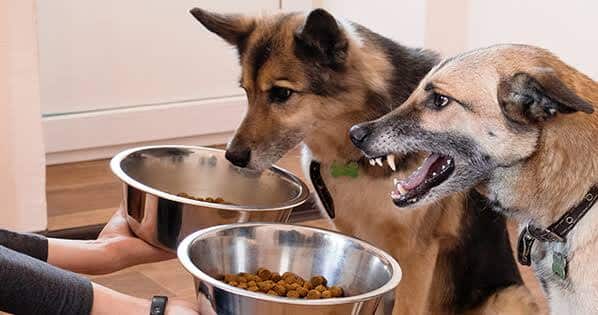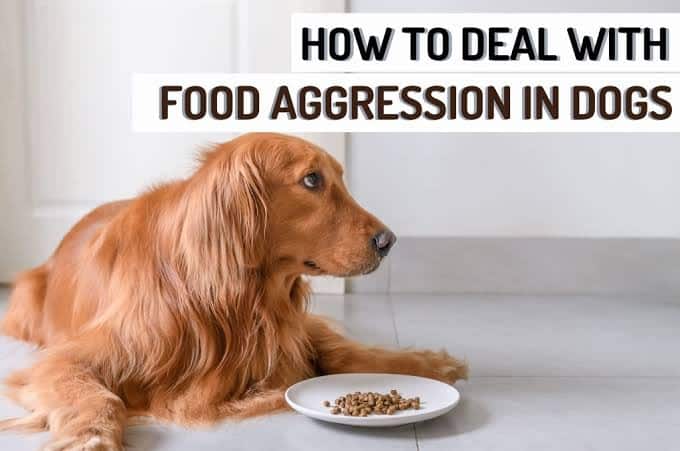Obviously, you must have observed food aggression in your Dogs or in the neighborhood. In the article, we will discuss all about “Food Aggression In Dogs”. Also, we will explore other aspects of the topic like; Understanding Food Aggression In Dogs, Types Of Food Aggression In Dogs, Impact Of Food Aggression On Dogs, Strategies For Managing Food Aggression In Dogs, etc.
Understanding Food Aggression In Dogs
This is crucial for ensuring a harmonious and safe environment for both pets and their owners. Food aggression, also known as resource guarding, is a common behavior problem that can manifest in dogs of all breeds and ages. Food aggression in dogs has causes, signs, and effective strategies for managing it.
Food aggression occurs when a dog perceives a threat to its food resources and reacts defensively to protect them. This behavior can range from mild growling or stiffening to more severe displays of aggression, such as snapping or biting. While food aggression may stem from various factors, including genetics, past experiences, or resource scarcity, it is essential for pet owners to recognize and address it promptly.
By understanding the root causes of food aggression and implementing appropriate training methods, pet owners can help their dogs develop healthier and safer mealtime behaviors, fostering a positive relationship built on trust and mutual respect.
See Also: Dog Muzzle For Barking
Types Of Food Aggression In Dogs
Mild Displays Of Food Aggression
This often involves subtle signs of discomfort or possessiveness around food resources. Common behaviors include stiffening, growling, or showing a raised lip when approached while eating. Dogs exhibiting mild food aggression may also tense up or freeze when someone approaches their food bowl.
Moderate Manifestations Of Food Aggression
Moderate food aggression typically involves more pronounced defensive behaviors aimed at protecting food resources. Dogs may display low-level aggression, such as snarling, snapping, or lunging, when approached while eating. They may also show signs of anxiety or stress, such as pacing or heightened alertness, during mealtime.
Severe Cases Of Food Aggression
This is characterized by intense and potentially dangerous behaviors aimed at guarding food resources. Dogs may exhibit aggressive displays, such as biting or attacking, when approached or when their food is threatened. These dogs may show little to no warning signs before escalating to aggressive behavior, posing a significant risk to themselves and others.

Impact Of Food Aggression On Dogs
Food aggression can have significant consequences for both dogs and their owners if left unaddressed. Understanding the impact of food aggression is crucial for pet owners to recognize the importance of managing and modifying this behavior effectively.
Risk Of Physical Injury
Dogs exhibiting food aggression may pose a risk of physical harm to themselves, other pets, or family members. Aggressive behaviors, such as biting or attacking, can result in serious injuries that require medical attention.
Stress And Anxiety
Dogs experiencing food aggression may feel heightened levels of stress and anxiety during mealtime. The fear of losing their food resources or being approached while eating can contribute to chronic stress, affecting their overall well-being and quality of life.
Disruption Of Dog-Owner Relationship
Food aggression can strain the relationship between dogs and their owners, leading to tension and mistrust. Dogs may perceive their owners as threats to their food resources, resulting in decreased bond and cooperation.
Decreased Socialization Opportunities
Dogs with food aggression may exhibit aggressive behaviors towards other dogs or humans, making it challenging to socialize them effectively. This can limit their ability to interact positively with others and participate in various activities, such as visits to the dog park or obedience classes.
Potential Legal Consequences
In severe cases, food aggression can result in legal consequences for pet owners if their dog injures someone during an aggressive episode. Dog bites and attacks can lead to lawsuits, fines, or even the euthanasia of the dog in extreme cases.
Impact On Household Harmony
Food aggression can disrupt household harmony and create tension among family members. Concerns about the dog’s behavior may lead to conflicts and disagreements on how to address the issue, further exacerbating the situation.
See Also: Why Do Dogs Whine?

Strategies For Managing Food Aggression In Dogs
1. Prevention Techniques For Puppies And Young Dogs
Start early: Begin training and socialization efforts with your puppy as soon as possible to prevent the development of food aggression.
Gentle handling: Handle your puppy’s food and food bowl regularly to accustom them to human interaction during mealtime.
Food-sharing exercises: Encourage positive associations with human presence around food by periodically adding treats or tasty additions to your puppy’s meal while they are eating.
2. Management Strategies For Adult Dogs With Food Aggression
Create a safe feeding environment: Feed your dog in a quiet, low-traffic area where they feel secure and are less likely to be disturbed.
Use a consistent feeding schedule: Establish a regular feeding routine to help reduce anxiety and prevent resource guarding behaviors.
Provide separate feeding areas: If you have multiple dogs, feed them in separate locations to avoid competition and minimize the risk of food aggression.
Supervise mealtime interactions: Stay nearby during your dog’s meals to monitor their behavior and intervene if necessary to prevent conflicts.
3. Desensitization And Counterconditioning Exercises
Gradual exposure: Gradually expose your dog to triggers that may elicit food aggression, such as approaching their food bowl or touching their food while they are eating.
Reward calm behavior: Use positive reinforcement techniques to reward your dog for remaining calm and relaxed during mealtime interactions.
Gradually increase difficulty: Slowly increase the level of difficulty by approaching closer to your dog or adding more challenging distractions while they eat.
4. Incorporating Positive Reinforcement Training Methods
Use rewards: Reward your dog with treats, praise, or toys for displaying non-aggressive behavior during mealtime interactions.
Avoid punishment: Avoid using punishment-based techniques, as they can increase fear and anxiety, exacerbating food aggression behavior.
Consistency is key: Be consistent in your training efforts and reinforce desired behaviors consistently to promote lasting change.
5. Implementing Structured Feeding Routines
Scheduled meals: Feed your dog at scheduled times rather than leaving food out all day to establish a routine and reduce the opportunity for resource guarding.
Mealtime manners: Teach your dog basic mealtime manners, such as sitting and waiting patiently for their food bowl to be placed on the ground, to promote calm and controlled behavior.

Seeking Professional Help For Food Aggression In Dogs
Persistent Aggression
If your dog’s food aggression persists despite your best efforts to manage and modify their behavior, it may be time to seek professional help.
Escalation Of Aggression
If your dog’s food aggression escalates to the point of causing injury or posing a significant risk to safety, immediate professional intervention is necessary.
Co-occurring Behavior Issues
If your dog displays other concerning behaviors in addition to food aggression, such as aggression towards humans or other animals, consulting with a professional is advisable.
Safety Concerns
If you feel unsafe or overwhelmed by your dog’s food aggression, do not hesitate to reach out to a veterinarian or dog behaviorist for assistance.
See Also: What Colors Can Dogs See
FAQs On Food Aggression In Dogs
1. What Is Food Aggression In Dogs?
Food aggression, also known as resource guarding, is a behavior problem where a dog displays aggressive behaviors, such as growling, snapping, or biting, when it perceives a threat to its food resources.
2. What Causes Food Aggression In Dogs?
Food aggression can stem from various factors, including genetics, past experiences, resource scarcity, lack of socialization, or learned behavior. Some dogs may develop food aggression as a survival instinct or as a result of anxiety or insecurity.
3. How Can I Recognize Signs Of Food Aggression In My Dog?
Signs of food aggression may include stiffening, growling, showing teeth, snapping, lunging, or biting when approached while eating. Dogs may also exhibit defensive behaviors, such as hovering over their food bowl or guarding their food from other pets or family members.
4. Is Food Aggression Common In All Dog Breeds?
Food aggression can occur in dogs of any breed, size, or age. While some breeds may be more predisposed to guarding behaviors due to their history or genetics, food aggression can manifest in any dog, regardless of breed.
5. How Can I Prevent Food Aggression In My Puppy?
Preventing food aggression in puppies involves gentle handling, positive reinforcement, and gradual socialization. Handle your puppy’s food and food bowl regularly, and encourage positive associations with human presence around mealtime.
6. Can Food Aggression Be Treated In Adult Dogs?
Yes, food aggression can be treated in adult dogs through behavior modification techniques, training exercises, and management strategies. Seeking guidance from a veterinarian or dog behaviorist can help develop a comprehensive treatment plan tailored to your dog’s specific needs.
7. Should I Use Punishment To Address Food Aggression In My Dog?
It is not recommended to use punishment-based techniques to address food aggression, as they can increase fear and anxiety, potentially exacerbating the problem. Instead, focus on positive reinforcement and reward-based training methods to promote desirable behaviors.
Conclusion
In summary, understanding and addressing food aggression in dogs is essential for promoting a safe and harmonious environment for both pets and their owners. Food aggression, while common, can pose risks to the well-being of dogs and those around them if left unaddressed. By recognizing the signs, understanding the causes, and implementing effective management and training techniques, pet owners can help their dogs develop healthier and safer mealtime behaviors.
It’s important to approach food aggression with patience, consistency, and a commitment to positive reinforcement. Punishment-based techniques should be avoided, as they can worsen the problem and damage the bond between dogs and their owners. Seeking professional help from a veterinarian or dog behaviorist can provide valuable guidance and support for addressing food aggression effectively.

